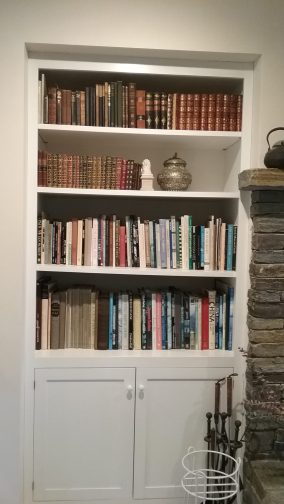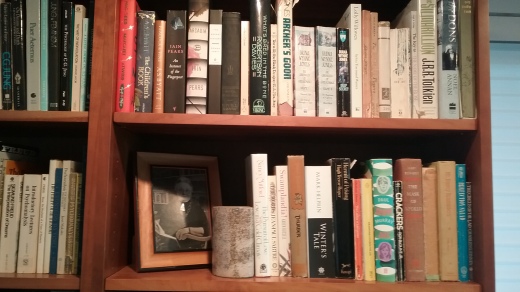Show Your Shelf!

Miniature of Cornificia (Corinse) in her study, from a Flemish translation of Christine de Pizan’s Cité des dames (‘De Lof der Vrouwen’), Bruges, 1475. British Library Add MS 20698, f.70r
Nowadays, even the Pope takes selfies. If you’re a committed writer and/or reader, though, you can get a better likeness than that. Share your shelfies, picture of your books. Give yourself a little leeway, and you can include your desk, your writing space and your reading corner. Why post a picture of your ugly mug? Show us your frontal cortex!
Here’s the most public of my shelfies, the bookcase beside my fireplace.  It displays the books most worth looking at as objects. Almost all of those on the top two shelves were my mother’s or my grandmother’s. They’re bound in leather, tooled in gold. (The books, not my progenitors, though they were pretty hidebound, too.) The stretch of identical bindings is a set of officially worthy books, some of which are indispensable, like Pride and Prejudice and Wuthering Heights, though I’d already read those in paperback before it occurred to me to look through the family holdings. On the other hand, Lord Charnwood’s biography of Abraham Lincoln will probably be up there, unmoved and undusted, when I die.
It displays the books most worth looking at as objects. Almost all of those on the top two shelves were my mother’s or my grandmother’s. They’re bound in leather, tooled in gold. (The books, not my progenitors, though they were pretty hidebound, too.) The stretch of identical bindings is a set of officially worthy books, some of which are indispensable, like Pride and Prejudice and Wuthering Heights, though I’d already read those in paperback before it occurred to me to look through the family holdings. On the other hand, Lord Charnwood’s biography of Abraham Lincoln will probably be up there, unmoved and undusted, when I die.
The tall books on the bottom shelves are mostly art and coffee table books. I have no memory at all of their provenance. I think people break in at night and drop them off to free up their own shelf space.
Below, in extreme contrast, is The Holy of Holies. Books have to be canonized to get here, and for this purpose, I am the Pope.  Most are fiction; a few belong on the history or science shelves. Atwood and Byatt are there, as are Pogo, the best of Diana Wynne Jones, and Perfection Salad, a study on the sociology of home cooking around 1900 that transports me to my grandmother’s kitchen. The woman in the picture is my best friend. A librarian, naturally.
Most are fiction; a few belong on the history or science shelves. Atwood and Byatt are there, as are Pogo, the best of Diana Wynne Jones, and Perfection Salad, a study on the sociology of home cooking around 1900 that transports me to my grandmother’s kitchen. The woman in the picture is my best friend. A librarian, naturally.
Next, my Purgatory. These, combined, constitute the To Be Read pile. I’ll spare you images of the Lowest Circle (books that have been sitting around so long I can’t remember what they’re about, let alone why I bought them) and the Middle Circle (books I still firmly intend to get to, only not just now, because the purchasing impulse did not convert quickly enough into the buckling down impulse. There’s a lot of nonfiction here.)
Finally, the TBR Upper Circle. These are probably going to make it into my brain within a year or so. I hardly had to rearrange the piles at all to display all my major interests (widdershins from top left): writing, the Israel/Palestine conflict, mysteries and Buddhism.  The mix stays the same all the way down. There are also a few specialized books picked up for research, for instance, a detailed description of a classic Yankee-clipper-era mansion and an endless account of everything known about the Abenaki people of New England. But I guess those come in under “writing.”
The mix stays the same all the way down. There are also a few specialized books picked up for research, for instance, a detailed description of a classic Yankee-clipper-era mansion and an endless account of everything known about the Abenaki people of New England. But I guess those come in under “writing.”
How about you, readers? What do your bookshelves look like? Are your shelfies a better likeness of the real you than what you see in the mirror?
Later addendum: Actually, it’s not your frontal cortex (which should have been “frontal lobe” anyway.) You read with your posterior parietal lobe. But somehow, “show us your posterior!” even with “parietal lobe” added, seems to change the tone.
Posted on May 20, 2017, in books, Heidi Wilson, reading, research, Uncategorized and tagged books, Corinse, Cornificia, Good Reads, selfies, shelfies, writing. Bookmark the permalink. 5 Comments.
It means to stand the test of time, or:
Hence phrs.: (1) to thole an (one’s) assize, Sc. Law: to stand trial; (2) to thole fire and water, of grain: to undergo processing at a mill, to be dried and ground in a mill, a translation of the feudal charter phr. grana quae aquam et ignem patiuntur. In 1821 quot. used jocularly = to be cooked.
(1)
Sc. 1800 Scots Mag. (May) 362:
He therefore contended that the pannels had not tholed an assize, and craved the Court to discharge the Jury without receiving their verdict.
Sc. 1811 J. Burnett Crim. Law 369:
Two objections were stated: one founded on the act 1701; and the other on the Common Law, — that no one is to thole an assize twice for the same crime.
Sc. 1827 Scott Journal (1891) 355:
The Advocate says she shall be tried anew, since she has not tholed an assize.
Sc. 1870 Justiciary Reports (1868–70) 394:
The suspender had been called on to plead, and evidence had been led. He had thereby tholed an assize.
Sc. 1954 Scotsman (17 Nov.) 7:
Once a jury was empanelled the accused was regarded as having tholed his assize.
LikeLike
“Tholled the assizes of time”?! No wonder you have no trouble plotting. You make things up!
LikeLike
Oh, I didn’t make THAT up.
LikeLike
Well….? Where is it from? And what the heck does it mean?
LikeLike
Shelfies! Only you could come up with a word for the inner you as opposed to the outer. I love it.
My juiciest TBR choices are in piles. My tried, but not true and therefore unfinished, are in piles. Books given to me or acquired via some other third party are in piles. My prized books that have tholled the assizes of time are on shelves where I lose them to the dust of the ages and have to reread them in new paperbacks or on my nook.
What does that say about me, I wonder.
LikeLike